‘It takes a village’: Celebrating the global army of selfless humanitarian workers

IMAGE Jerome Cristobal
MANILA, Philippines—Whenever and wherever people are in crisis, there are those who are always ready to help—humanitarian workers.
The United Nations (UN) said these workers are people in need of help themselves but are always the first to respond when disaster strikes. The global community that supports them sees their needs, too, as they recover.
To recognize them, UN marks Aug. 19 of every year as World Humanitarian Day (WHD), a celebration that recognizes the selfless sacrifices of aid workers all over the world.
This, as a bomb attack in Baghdad, Iraq killed 22 humanitarian workers, including Sergio Vieira de Mello, the special representative of the UN secretary general for Iraq, on Aug. 19, 2003.
Five years later, the UN General Assembly adopted a resolution setting up the celebration, which brings together everyone who advocates for the survival, wellbeing and dignity of people in crises, and for the safety and security of humanitarian workers.
Article continues after this advertisementThis year, UN said WHD shines light on the thousands of volunteers, professionals, and crisis-hit people who deliver immediate health care, shelter, food, protection, water, and a lot more.
Article continues after this advertisement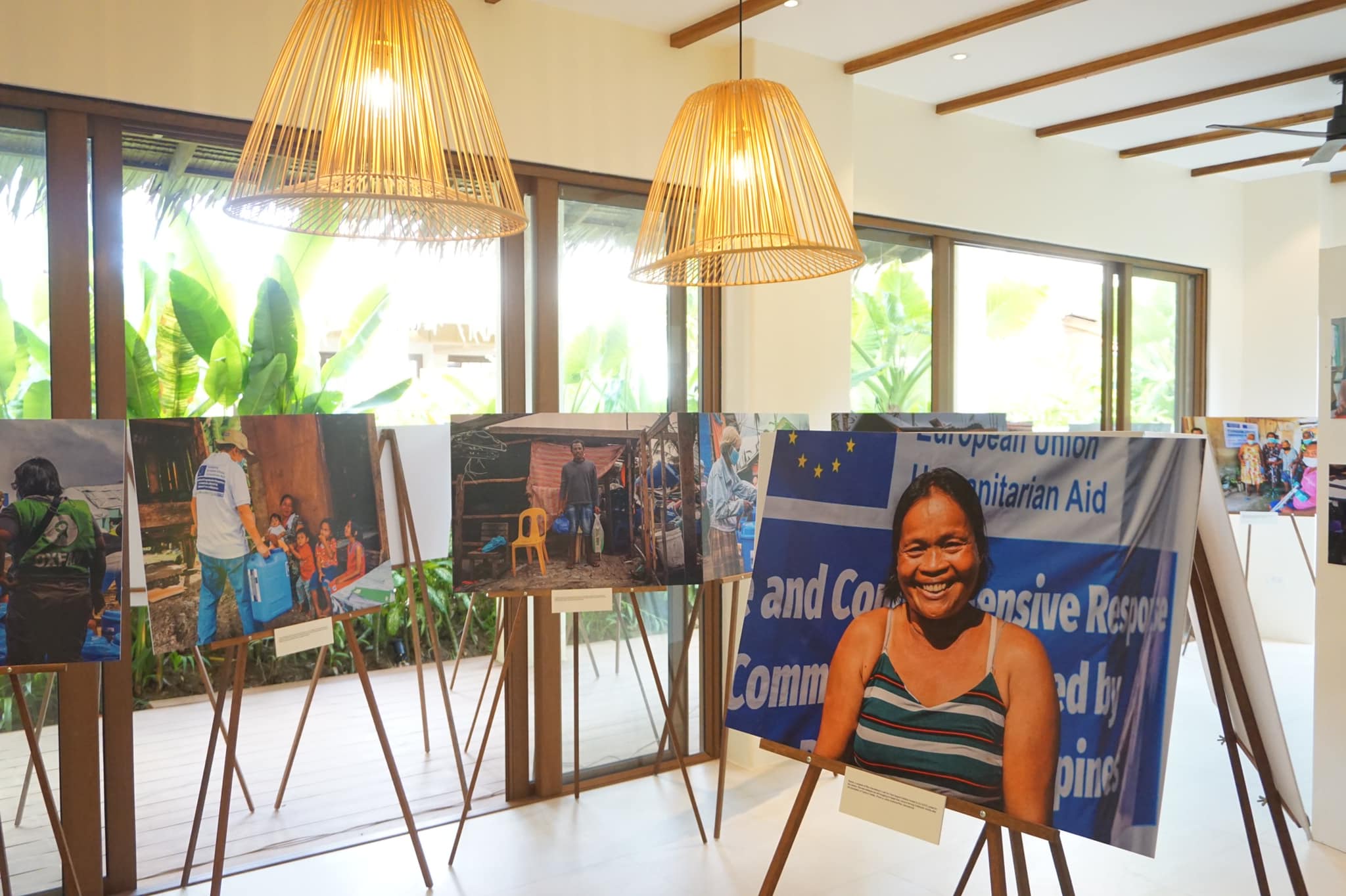
HELPING IN TIMES OF CRISES. Aid workers open a photo exhibit in Siargao to raise awareness about the impact of Typhoon Odette (Rai) and the concerted efforts in rebuilding the affected communities. PHOTO COURTESY OF OXFAM PILIPINAS
“It takes a village to support a person in a humanitarian crisis. With record-high humanitarian needs around the world, this year’s WHD builds on this metaphor of collective endeavor to grow global appreciation of humanitarian work,” it said.
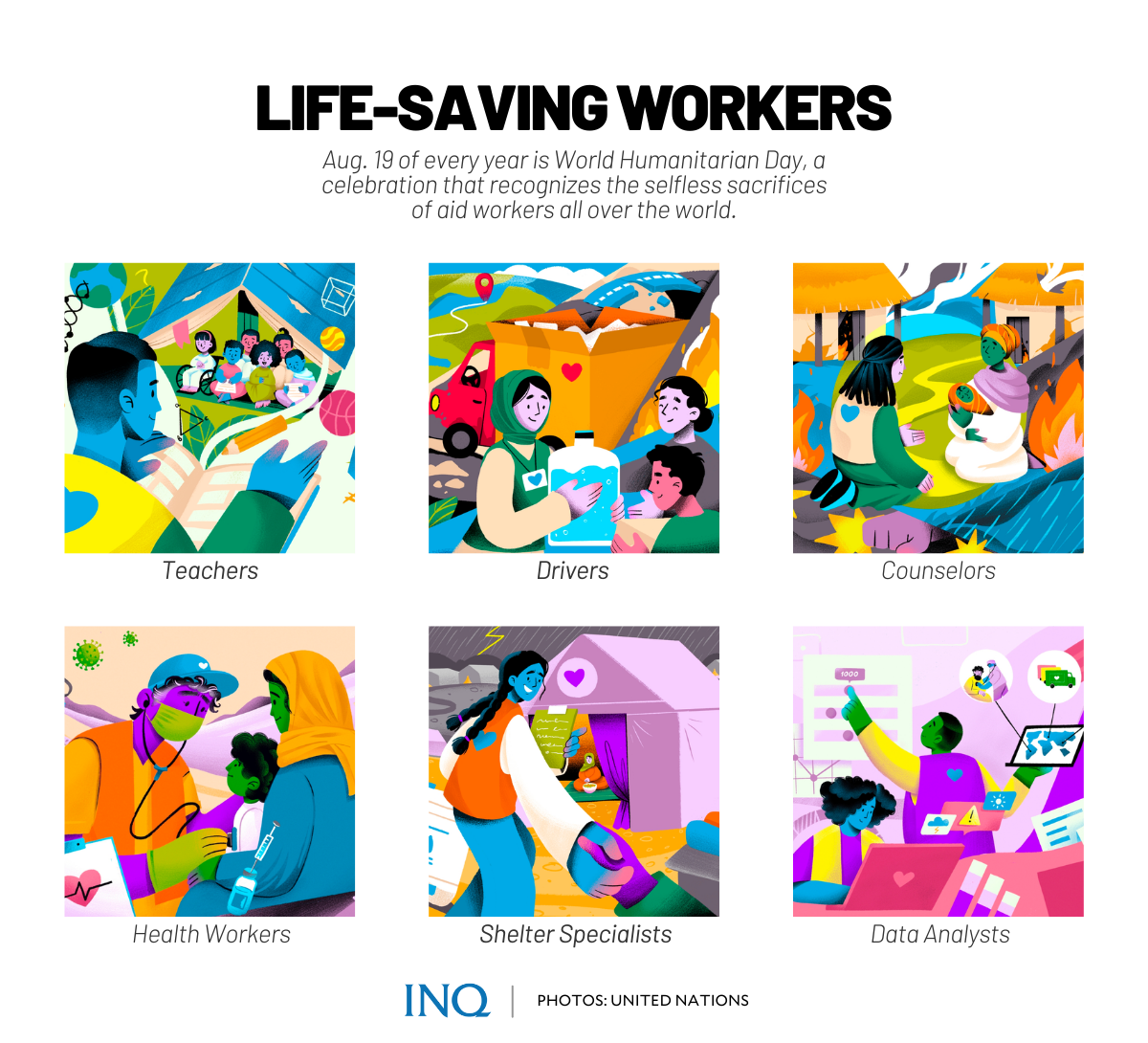
GRAPHIC Kurt Dela Peña
UN said far from the spotlight and out of the headlines, they come together—volunteers, professionals, and even crisis-hit people—to ease suffering and bring hope.
They are teachers, drivers, counselors, health workers, shelter specialists, data analysts, protection officers, water specialists, security advisers, emergency responders, advocates, fundraisers, and negotiators.
- Teachers
They help children learn so they do not risk losing their future, and they ensure children have safe environments, protecting them from physical dangers including abuse, exploitation and recruitment into armed groups.
Teachers also offer psychosocial support to children—especially girls, children with disabilities, internally displaced children, refugees and migrants—giving stability and structure to help them cope with the trauma of living through a humanitarian crisis.
Last year, almost 110 million children in emergency settings accessed formal or non-formal education, including early learning. Likewise, over 896,900 refugee children and children from host communities were supported with connected or home-based learning in 80 countries.
- Drivers
When there is an emergency, relocating disaster-stricken people, transferring casualties and getting vital supplies to people in need is a matter of life and death. Just as important is transporting relief workers and volunteers to crisis-hit communities.
They transport people and cargo over long distances and to remote areas, and often under precarious security situations. They deliver life-saving supplies across combat lines and after sudden onset of disasters.
- Counselors
UN said caring for people’s mental health and physical wellbeing are equally important. In crisis situations, people lose their loved ones, their homes, possessions and livelihoods, and their sense of hope.
Survivors can also suffer severe violations of human dignity, such as torture and sexual violence. Left untreated, these often-hidden wounds can cause serious and long-term harm to individuals, families, communities and entire societies.
- Health Workers
As crises affect millions of people, a broad range of health care workers is essential to humanitarian work. For affected communities, doctors, nurses, midwives and nutrition experts are often their first and only link to essential health services during crises.
UN said they travel to hard-to-reach communities where medical services are lacking, and they stay behind to care for people in conflict zones and ensure health services are available to all, particularly vulnerable people including women, girls, children, people with disabilities and the elderly.
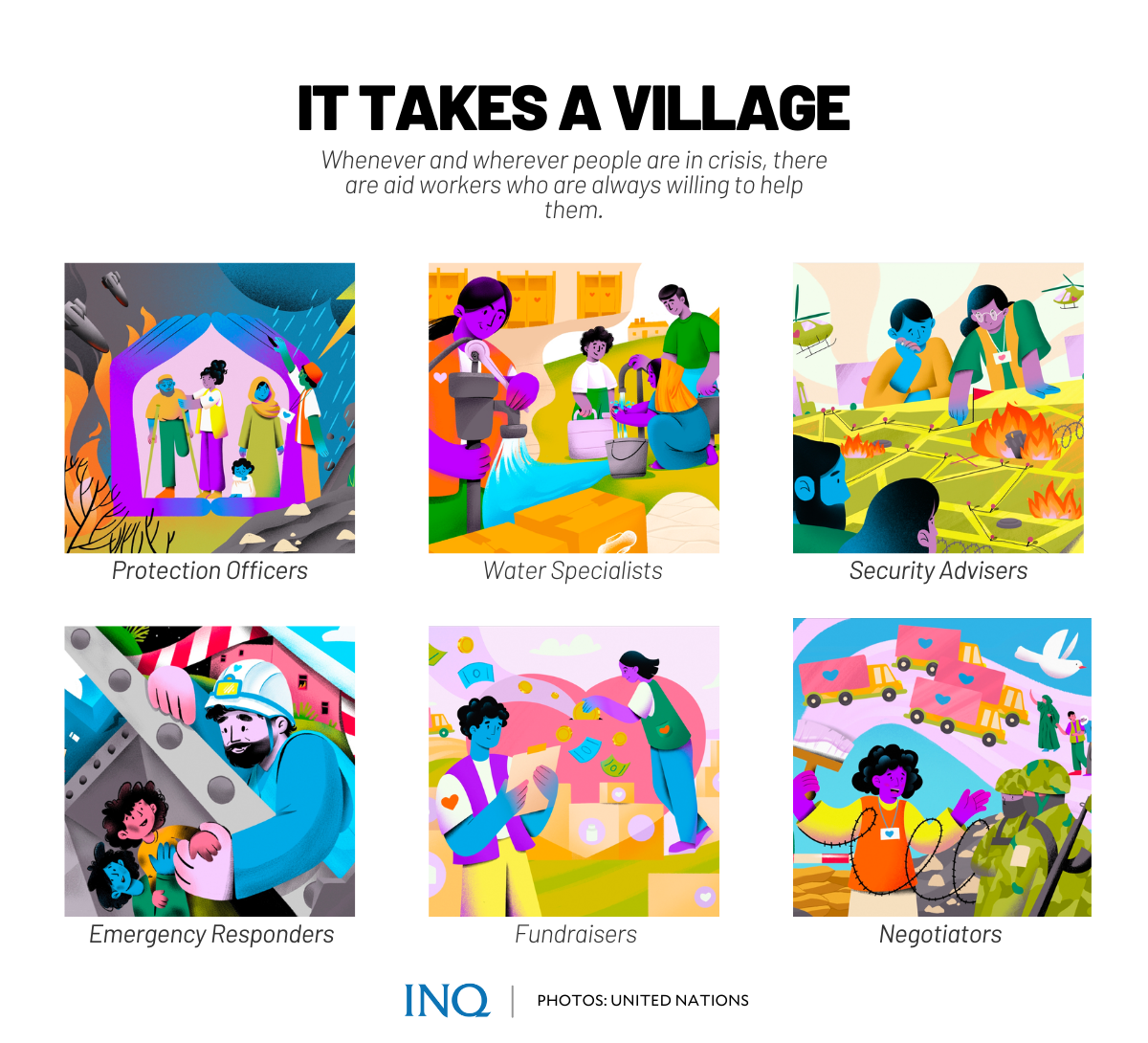
GRAPHIC Kurt Dela Peña
- Shelter Specialists
The UN stressed that in displacement situations or the aftermath of a disaster, safe and adequate shelter is essential for the immediate survival of affected people. It is also critical to protect their privacy and dignity and to support their resilience.
Last year, over 6.6 million people received shelter support across 13 countries.
Likewise, over 1,500 local actors were trained in camp coordination and camp management across 17 countries.
- Data Analysts
This, as humanitarians need up-to-date, reliable and accurate data and information to make well-informed decisions. Likewise, crisis-hit communities need access to information that enables them to find assistance and decide their next steps.
They gather, analyze and publish data and information so that humanitarians can understand the context of a crisis, people’s needs, the locations and demographic make-up of affected communities, and which organizations are providing assistance.
- Protection Officers
Weather shocks, insecurity and conflict put people’s lives in danger and erode their wellbeing, the UN said. Protection officers help people stay safe, recover from harm and access their rights.
Protection officers have a wide range of duties. They may search for missing persons and reunite separated families, and they speak with detainees and the displaced and wounded to understand their needs.
- Water Specialists
When there are wars and disasters, water, sanitation and hygiene (WASH) are essential to life, health and dignity. Without them, the risk of sickness and disease outbreaks—especially among children—is high.
In 2021, 26.9 million people received critical water, sanitation and hygiene supplies and services. Likewise, 34 million people, some forcibly displaced, accessed safe water for drinking, cooking and personal hygiene.
- Security Advisers
Humanitarian work often takes place in dangerous and unstable contexts, especially following conflicts and disasters. Security professionals provide services that enable humanitarians to deliver life-saving programs safely and securely.
But sadly, the role of security professionals is becoming increasingly important. The number of major attacks against aid workers more than doubled between 2000 and 2020.
Last year, 460 aid workers were attacked: 140 killed, 203 wounded and 117 kidnapped. Out of the 140 who died, 98 percent were national staffers and 2 percent were international (expatriate) staffers – more than half (53 percent) were staffers of national NGOs.
- Emergency Responders
When disasters strike, time is of the essence in saving lives. Following a major crisis, emergency-service personnel, such as firefighters, search-and-rescue teams and ambulance operators, are often first on the scene, treating the sick and injured, providing safety, locating people and evacuating the wounded.
They provide vital support, including relocating people from areas of active fighting. Most emergency-service personnel are volunteers operating in their home communities, but international emergency response teams deploy to help disaster-affected countries.
- Advocates
From communications specialists in crisis settings to behind-the-scenes negotiators and diplomats to top-level senior officials, such as those in the global Emergency Relief Coordinator, humanitarian advocates make sure world leaders pay attention and, more importantly, take action.
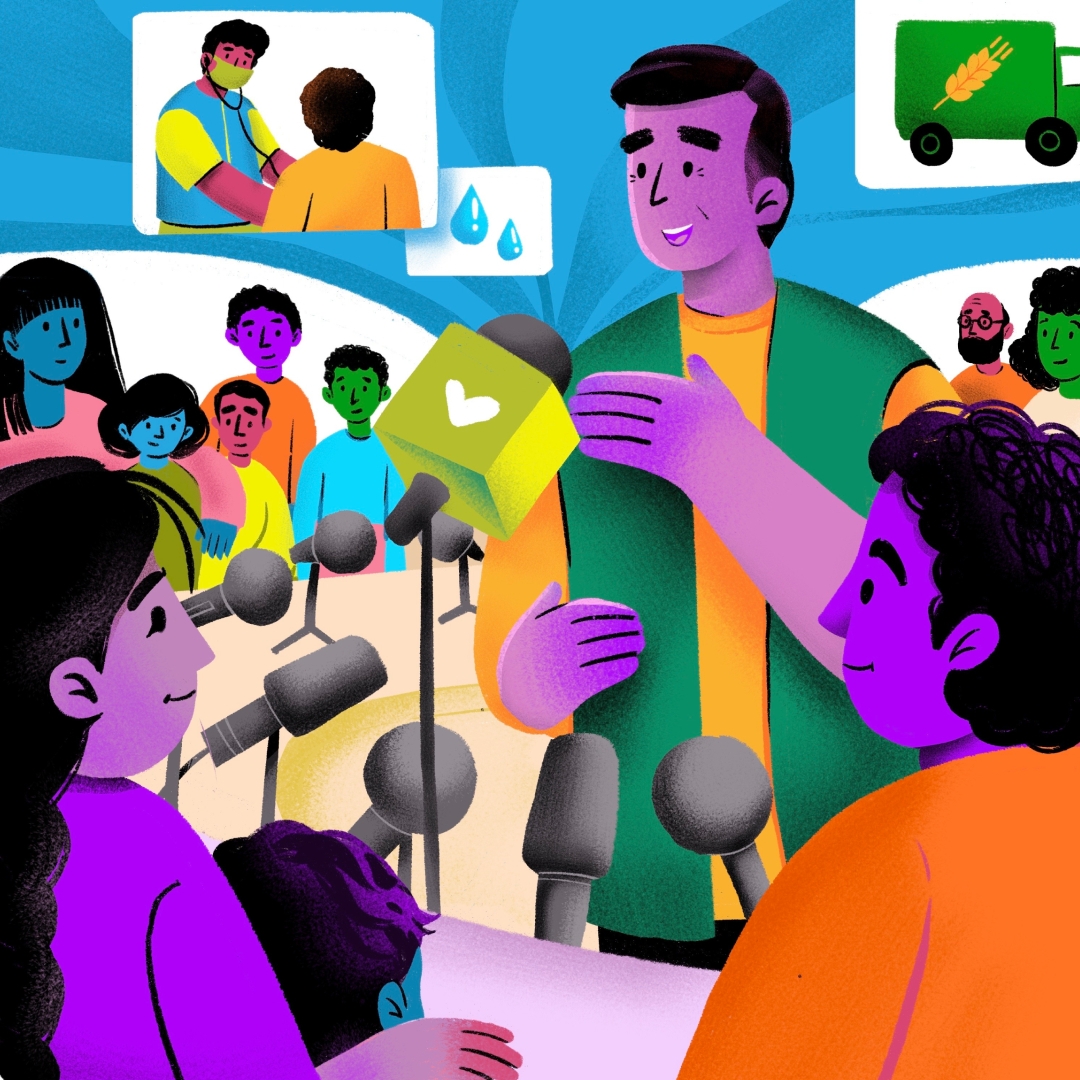
ARTWORK United Nations
The UN said it is because when people are hit by a crisis, they need the world to hear, understand and quickly respond. Advocates amplify the voices of people in need, mobilize funds and supplies, shine a spotlight on forgotten crises and urge respect for international humanitarian law.
- Fundraisers
When disasters strike, fast and flexible funding is essential for saving lives. It enables humanitarian workers and organizations on the front lines to provide emergency services and immediate relief, such as food, water, shelter, medical support and protection.
From charity fundraisers to national governments, and from small and big businesses to celebrities and the public, their generous and timely support contributes to speedy, life-saving humanitarian action for people caught in humanitarian crises around the world.
- Negotiators
Humanitarians must be able to reach people in need to provide assistance. Equally, affected communities must be able to access that assistance themselves. Access is fundamental to effective humanitarian action.
UN said that in some situations—especially in situations of armed conflict—negotiators must engage with parties who hinder humanitarian access and with those who can facilitate it.
Aid workers in PH
Since Sunday (Aug. 14), Oxfam Pilipinas has been showcasing humanitarians’ often invisible, but always indispensable work, saying that in crises, aid workers always strive to save lives.
Especially in the Philippines, which is hit by an average of 20 typhoons and 100 to 150 earthquakes every year, millions of people have been extended life-saving assistance by humanitarian workers.
READ: PH’s typhoon alley and the trail of destruction it brings
Just last July 27, the province of Abra was hit by a magnitude 7.0 earthquake, which left 11 people dead and billions of pesos worth of damage—infrastructure (P1.81 billion) and agriculture (P56.40 million).
READ: Abra earthquake death toll rises to 11 — NDRRMC
Last year, Dec. 16, the Visayas and Mindanao were also devastated by Typhoon Odette (Rai), which was the strongest in 2021. The disaster left 407 people dead and P28 billion worth of damage to infrastructure and agriculture.
READ: Odette: Impact on PH described as ‘catastrophic’

GRAPHIC Ed Lustan
While the typhoon made Christmas bleak, especially for the affected residents, Malacañang had expressed gratitude to countries and civil society organizations that extended help to people affected by the crisis.
Likewise, when the earthquake hit Abra and the rest of northern Luzon, Save the Children Philippines immediately deployed a team to conduct an assessment and initial response activities, especially for children and their families.
READ: LIST: Killer earthquakes in the Philippines
It said it would work with the local government for immediate assistance to 1,000 households, which includes the provision of vital necessities like household kits, emergency shelters, cans for the storage of potable water, and hygiene kits.
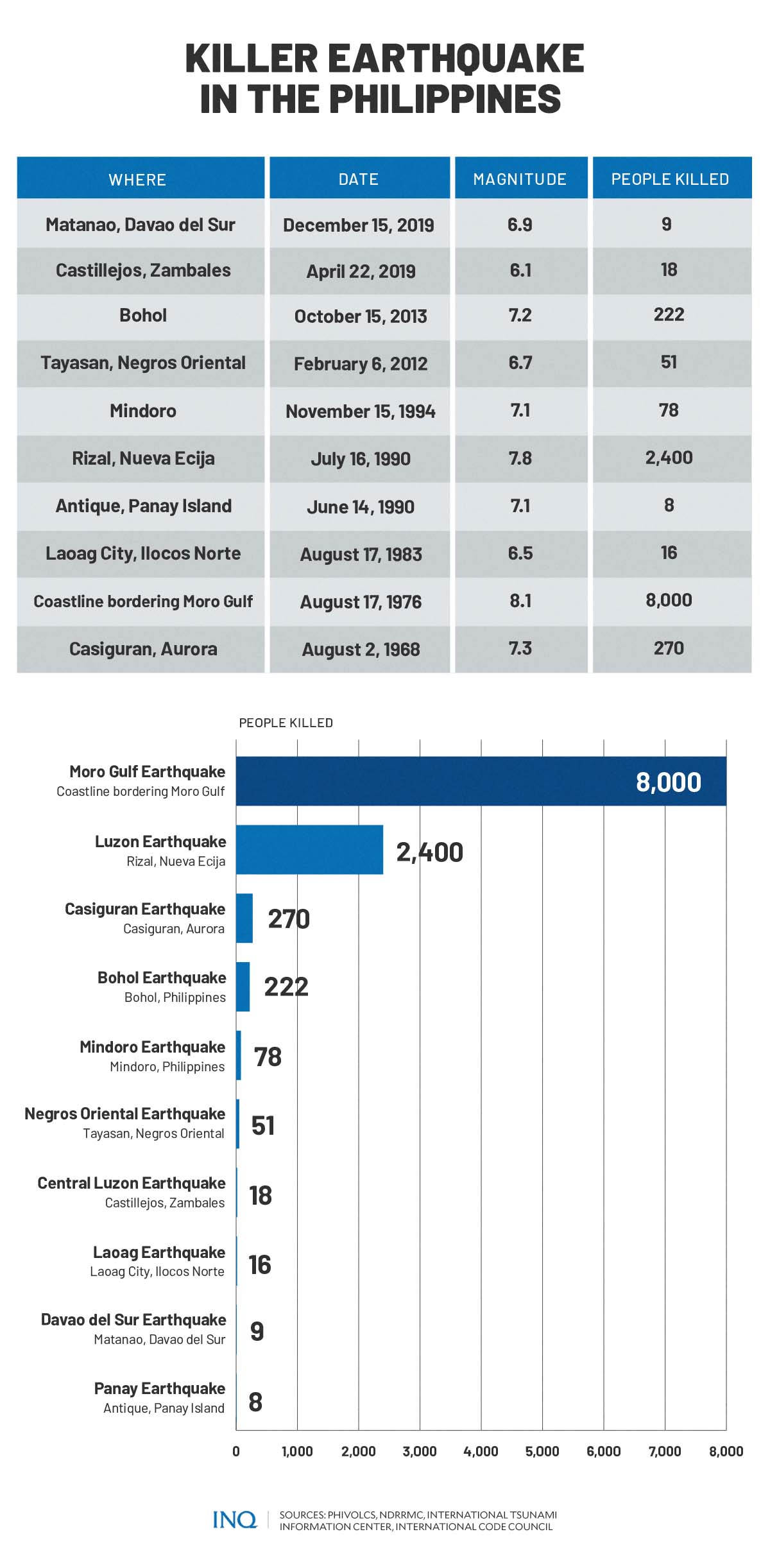
GRAPHIC Ed Lustan
PH heroes
WHD, which is a campaign by the UN Office for the Coordination of Humanitarian Affairs, depicts the importance, effectiveness and positive impact of aid work.
When Cagayan and Isabela were ravaged by massive flooding in 2020, the year the COVID-19 crisis hit, Raul Ting, who was from Tuguegarao City himself, had coordinated most of the assistance for affected residents.
He told INQUIRER.net that from the first day of the flooding until the fourth day, he had received calls from non-government organizations, coordinating relief operations not only for Cagayan, but also in Catanduanes, which was likewise ravaged by a typhoon.
Save the Children Philippines had featured the story of 29-year-old Jerome Balinton, who is one of its passionate and hardworking humanitarians for the country.
He was first deployed on Oct. 15, 2013, when a magnitude 7.2 earthquake hit Bohol and affected over three million people, including children and infants who experienced heavy stress.
READ: Bohol quake ‘like 32 Hiroshima bombs’
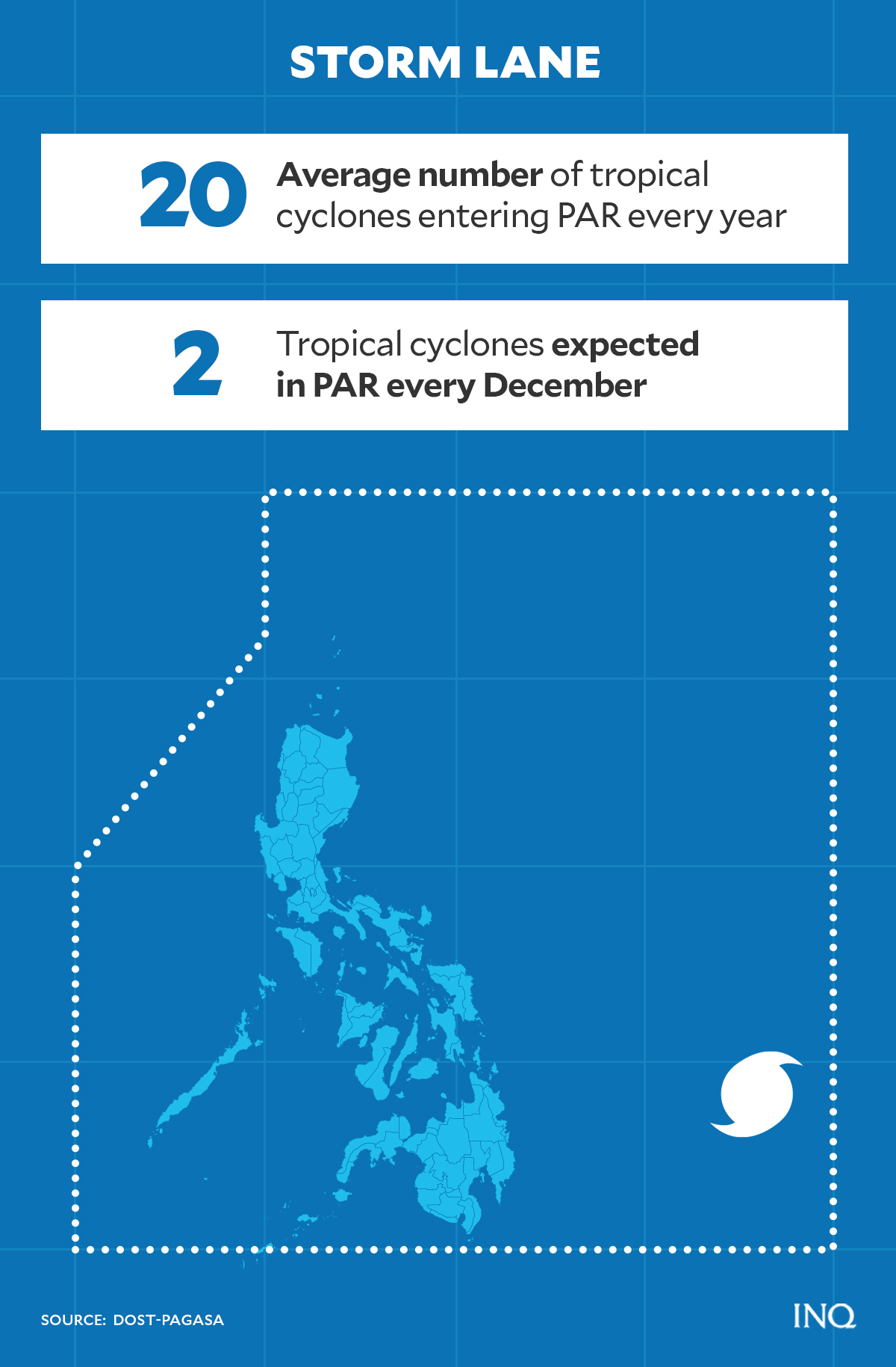
GRAPHIC Ed Lustan
A month later, Balinton was again deployed to the Visayas in the aftermath of Super Typhoon Yolanda (Haiyan), which left 6,000 people dead and a suffering that continued for months and even years.
READ: IN PHOTOS: Looking back at Super Typhoon Yolanda’s onslaught in 2013
Then on June 6, 2017, as the Marawi crisis broke out, he was assigned to Mindanao: “And it is nearly two months of being in the field, responding to the needs, and leading the team in providing assistance to the children and schools with urgent needs.”
He said, however, that humanitarian work comes not only with physical exhaustion, but emotional and mental stress. He said, though, that “I see myself continuously doing humanitarian work in the years to come.”
“One of the most challenging parts of being involved in humanitarian missions is to keep yourself emotionally, psychologically, and physically healthy [but] children keep me going,” he said.